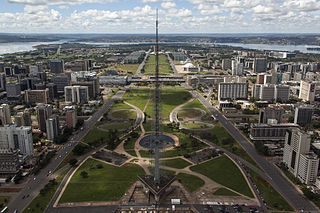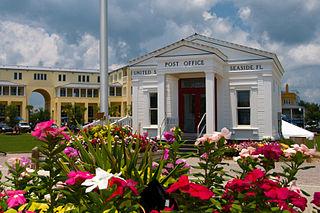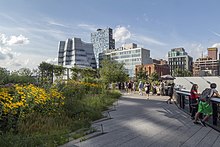
Urban design is an approach to the design of buildings and the spaces between them that focuses on specific design processes and outcomes. In addition to designing and shaping the physical features of towns, cities, and regional spaces, urban design considers 'bigger picture' issues of economic, social and environmental value and social design. The scope of a project can range from a local street or public space to an entire city and surrounding areas. Urban designers connect the fields of architecture, landscape architecture and urban planning to better organize physical space and community environments.
DPZ CoDesign (DPZ) is an architecture and town planning firm based in Miami, Florida, founded in 1980 by the husband-and-wife team of Andrés Duany and Elizabeth Plater-Zyberk. The firm advocates for New Urbanist town planning in the United States and other countries, having completed designs for over 300 new and existing communities. In addition to Duany and Plater-Zyberk, DPZ's partners include Galina Tachieva, Marina Khoury, Senen M. A. Antonio and Matthew J. Lambert.

New Urbanism is an urban design movement that promotes environmentally friendly habits by creating walkable neighbourhoods containing a wide range of housing and job types. It arose in the United States in the early 1980s, and has gradually influenced many aspects of real estate development, urban planning, and municipal land-use strategies. New Urbanism attempts to address the ills associated with urban sprawl and post-Second World War suburban development.

A landscape architect is a person who is educated in the field of landscape architecture. The practice of landscape architecture includes: site analysis, site inventory, site planning, land planning, planting design, grading, storm water management, sustainable design, construction specification, and ensuring that all plans meet the current building codes and local and federal ordinances.

Urbanism is the study of how inhabitants of urban areas, such as towns and cities, interact with the built environment. It is a direct component of disciplines such as urban planning, a profession focusing on the design and management of urban areas, and urban sociology, an academic field which studies urban life.
Charles Morris Anderson is a landscape architect and fellow of the American Society of Landscape Architects, He is a Principal of the Phoenix-based landscape architecture firm, Charles Anderson Landscape Architecture, which is the continuation of his practice of the Seattle-based firm Charles Anderson Landscape Architecture.

Andrés Duany is an American architect, an urban planner, and a founder of the Congress for the New Urbanism.
The urban-to-ruraltransect is an urban planning model created by the New Urbanist Andrés Duany. The transect defines a series of zones that transition from sparse rural farmhouses to the dense urban core. Each zone is fractal in that it contains a similar transition from the edge to the center of the neighborhood. The transect is an important part of the New Urbanism and smart growth movements. Duany's firm DPZ has embodied the transect philosophy into their SmartCode generic planning code for municipal ordinances.
Landscape planning is a branch of landscape architecture. According to Erv Zube (1931–2002) landscape planning is defined as an activity concerned with developing landscaping amongst competing land uses while protecting natural processes and significant cultural and natural resources. Park systems and greenways of the type designed by Frederick Law Olmsted are key examples of landscape planning. Landscape designers tend to work for clients who wish to commission construction work. Landscape planners analyze broad issues as well as project characteristics which constrain design projects.
James Corner is a landscape architect and theorist whose works exhibit a focus on "developing innovative approaches toward landscape architectural design and urbanism." His designs of note include Fresh Kills Park on Staten Island and the High Line in Manhattan, and Domino Park in Brooklyn, all in New York City.

Mohsen Mostafavi is an Iranian-American architect and educator. Mostafavi is currently the Alexander and Victoria Wiley Professor of Design at the Harvard Graduate School of Design. From 2008 through 2019, Mostafavi served as the school's dean.

West 8 is an urban planning and landscape architecture firm founded by Adriaan Geuze and Paul van Beek in Rotterdam, Netherlands in 1987. It is known for its contemporary designs and innovative solutions to urban planning problems using lighting, metal structures, and color. Van Beek is no longer part of the firm.

Walter J. Hood is an American professor and former chair of landscape architecture at the University of California, Berkeley, and principal of Hood Design Studio in Oakland, California. In 2019, Hood was awarded a MacArthur Fellowship, known as the "Genius Grant".
Ecological urbanism draws from ecology to inspire an urbanism that is more socially inclusive and sensitive to the environment. It is less ideologically driven, than green urbanism or sustainable urbanism. In many ways, ecological urbanism is an evolution of, and a critique of, Landscape Urbanism arguing for a more holistic approach to the design and management of cities. This type of urbanism has a central scope of four main objectives: Compactness, complexity, efficiency, and stability. This model of Urbanism strives to tackle the current challenges of society by intertwining sustainability and urban occupation models. "Ecological urbanism" was coined by architect and planner Miguel Ruano in his 1998 book Eco-Urbanism: Sustainable Human Settlements, 60 Case Studies. The term first appeared as "EcoUrbanism", which is defined as "the development of multi-dimensional sustainable human communities within harmonious and balanced built environments". The term was used later in April 2003 at a conference at the University of Oregon, and again in 2006 in a paper by Jeffrey Hou. Mohsen Mostafavi used the term in the 2007 publication Intervention Architecture and in a lecture at the Canadian Centre for Architecture. Today, ecological urbanism is recognized as a formal academic research topic. Notably, the Harvard University Graduate School of Design has conducted a conference, held an art exhibition, and published a book all centered around ecological urbanism.

Kongjian Yu, is a landscape architect and urbanist, writer and educator, commonly credited with the invention of Sponge City concept, and winner of the International Federation of Landscape Architects’ Sir Geoffrey Jellicoe Award in 2020. Received his Doctor of Design Degree from Harvard Graduate School of Design in 1995, Doctor Honoris Causa from Sapienza University of Rome in 2017 and Honorary Doctorate from Norwegian University of Life Sciences in 2019, Yu was elected to the American Academy of Arts and Sciences in 2016.

Terreform ONE is a 501c3 non-profit architecture and urban think tank that advances ecological design in derelict municipal areas. By formulating unsolicited feasibility studies and egalitarian designs, their mission is to illustrate speculative environmental plans for New York City and other cities worldwide. Their intention is to support community outreach and master plan solutions in underprivileged areas that do not have direct access to qualified architects and urban designers.
Jeff Speck is an American city planner, writer, and lecturer who is the principal at the urban design and consultancy firm, Speck & Associates. He has authored or co-authored several books on urban planning, including his 2012 book, Walkable City: How Downtown Saves America, One Step at a Time. He is an advocate for New Urbanism and more "walkable" cities and has given TED Talks on the subjects.

Nina-Marie Lister is Professor and Graduate Director of the School of Urban and Regional Planning at Toronto Metropolitan University, where she also leads the Ecological Design Lab. In 2021, she was appointed a Senior Fellow of Massey College. From 2010 to 2014, she was a Visiting Associate Professor of landscape architecture and urban planning at Harvard Graduate School of Design. Her career has spanned private and public-sector work, integrating ecological science with planning and design. As both a researcher and a practitioner, she is founding principal of PLANDFORM, a creative design practice. Lister's work focuses on the intersection of landscape infrastructure and ecological processes in metropolitan areas.

Sarah Bekessy is an Australian interdisciplinary conservation scientist with a background in conservation biology and experience in social sciences, planning, and design. Her research interests focus on the intersection between science, policy, and the design of environmental management. She is currently a professor and ARC Future Fellow at RMIT University in the School of Global, Urban and Social Studies. She leads the Interdisciplinary Conservation Science Research Group.

Ana Maria Duran Calisto is an Ecuadorean architect, urbanist, and environmental planner who founded Estudio A0 with her husband and partner the architect Jaskran "Jazz" Kalirai in Quito, Ecuador.















